On June 12, 2009, I attended a bubble battle in New York. But the event wasn’t really a battle — at least not in the traditional sense. Hundred of people who didn’t know each other gathered in Times Square to blow bubbles. It seemed like such a simple act, but it turned out to be so much more. And I hope that the above film, “Bubbles: A Consideration,” gives anyone who wasn’t able to attend a sense of the possibilities.
Tag / New York

The Bat Segundo Show: John Wray
John Wray appeared on The Bat Segundo Show #282.
John Wray is most recently the author of Lowboy.
Condition of Mr. Segundo: Searching for those who will listen to him in the subway.
Author: John Wray
Subjects Discussed: The ABAB narrative of Lowboy, mirroring schizophrenia within a narrative structure, a sane perspective that assists the reader, subway details, Franz Kafka’s Amerika, real vs. imaginary details, Jonathan Zizmor, the C#/A subway tone, the origin of the character name Heller, Ulysses, resisting eccentric character names, merging two words into one unhyphenated word, A Portrait of the Artist as a Young Man, ideal seating positions in a subway, appealing to a wider audience, balancing the uncompromising literary voice with suspense, comparing the research in Wray’s three books, the difficulties of convincing the reader, Daniel Paul Schreber’s Memoirs of My Nervous Illness, sexual preoccupation and schizophrenia, an intimate third-person voice, the relationship (or lack thereof) between Freud and Schreber, pat summations, urban exploration, the benefits of imagination, the Sikh religion and the end of the Seventh Avenue Line, open interpretations and false connections, respect for the subconscious, the old City Hall station, the dangers of being subsumed by research, writing vs. thinking, graphical segues in prose, B.S. Johnson’s holes, and John Wray vs. John Henderson.
EXCERPT FROM SHOW:
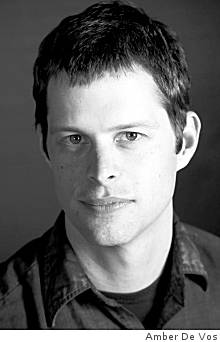 Correspondent: You have Emily and Lowboy entering at the 14th Street station. I’m going to get subway geeky with you here.
Correspondent: You have Emily and Lowboy entering at the 14th Street station. I’m going to get subway geeky with you here.
Wray: Okay.
Correspondent: I should point out that when you get into Union Square, there is — or there is now and there won’t be very soon — a Virgin Megastore.
Wray: Right.
Correspondent: Was that particular location a deliberate choice on your part?
Wray: (laughs) You know, sometimes there are just these happy accidents that come about either completely by chance or through some sort of action of the subconscious. I’m not really sure. The German editor of Lowboy was very proud of himself for the game of interpretation that he played, which involved a lot of reversals and mirror image analyses, that I guess you could say. He was very proud of himself for having been the only person to discover that the name of the detective in the novel, Ali Lateef..
Correspondent: Either the jazz artist or even the hip-hop artist in Oakland.
Wray: Well, there’s that. Yeah, that was a conscious reference on my part. But this German editor of mine was very proud to have figured out that Lateef spelled backwards is “fetal.”
Correspondent: Yes.
Wray: Which is something that I never thought of. In a million years, I wouldn’t have thought of that. And I still don’t know what he was getting at. But who knows? I mean, it’s quite possible that these things percolate up from the subconscious in some way.
Correspondent: But I also must point out that the 86th Street Station does not have a line that you can see across, as you point out in this particular book. This led me then to believe as I was reading it, “Oh! Is this really real or not?” It was a kind of clue. Deliberate choice on your part?
Wray: Well, I deliberately — I’ve always been a big fan of Franz Kafka’s novel, Amerika. Particularly of the way that Amerika begins. Amerika, of course, being a novel written by someone who had never been to America and who was making deliberate use of the myth of America as a way of addressing many other things. Kafka was not particularly interested in the United States. And in the beginning of the novel Amerika, this boat filled with immigrants enters New York Harbor. And one of the very first sentences describes the Statue of Liberty holding aloft its wonderful gleaming sword.
Correspondent: Yeah.
Wray: Rather than the torch, of course. So in an earlier version of Lowboy, in a bit of a tip of the hat to that novel, I introduced various, fairly overt features into this New York City that would differentiate it from the New York of realistic fiction. Then as the novel evolved, it became more and more naturalistic in a way, and eventually settled into this mode of heightened realism that it now occupies. But there are still certain little vestiges of that earlier alternative New York.
Correspondent: And this would be one of them.
Wray: I think you’ve caught one of them. Yeah.
BSS #282: John Wray (Download MP3)

C Rock
 The cracked light turquoise paint clings to the gneiss on the Bronx side of Spuyten Duyvil Creek, forming the canvas for a stenciled C, a character cloud with a silver lining representing Columbia University. I can report with some small relief that elite rowers are in short supply on a cold February afternoon. But the Amtrak trains that roll across the bridge to the west of the Henry Hudson can be seen emerging on the Bronx side and disappearing behind the Big C. While the rock itself has defiantly exacted fissures through serious chunks of this not-quite-elliptical letter, the paint sits truer near the stems. And you can walk a good hard slog through Inwood Hill Park, slipping on the presently icy trails under the Henry Hudson Bridge leading southwest to Dyckman Street, and not know a damn thing about how the C came to be. You’ll run into friendly geese, with their sinuous necks jutting as slow and methodical and as graceful as their struts, and encounter a number of maps displaying city department propaganda about all the forest preservation going on. But what of the origins of C Rock itself? Nothing. An unknown letter defying history, standing some sixty feet tall but somehow still managing to upstage the large chunks of ice now breaking in the water.
The cracked light turquoise paint clings to the gneiss on the Bronx side of Spuyten Duyvil Creek, forming the canvas for a stenciled C, a character cloud with a silver lining representing Columbia University. I can report with some small relief that elite rowers are in short supply on a cold February afternoon. But the Amtrak trains that roll across the bridge to the west of the Henry Hudson can be seen emerging on the Bronx side and disappearing behind the Big C. While the rock itself has defiantly exacted fissures through serious chunks of this not-quite-elliptical letter, the paint sits truer near the stems. And you can walk a good hard slog through Inwood Hill Park, slipping on the presently icy trails under the Henry Hudson Bridge leading southwest to Dyckman Street, and not know a damn thing about how the C came to be. You’ll run into friendly geese, with their sinuous necks jutting as slow and methodical and as graceful as their struts, and encounter a number of maps displaying city department propaganda about all the forest preservation going on. But what of the origins of C Rock itself? Nothing. An unknown letter defying history, standing some sixty feet tall but somehow still managing to upstage the large chunks of ice now breaking in the water.
It is commonly understood that a rowing team from Columbia University painted the rock out of school pride. Bill Twomey’s The Bronx suggests an alternate theory: that the rock was painted by engineering students from Columbia and the blue paint was purchased by George Younkheere (along with brushes and rope). In 1994, the New York Times reported that the peninsula was destroyed sometime in 1937 to widen the Harlem River Ship Canal, where the C was later painted. The Times also helpfully informs us that the paint is replenished every few years by Columbia crews. But who? And what authority determines how frequently the rock must be painted? Another Times article four years later informs us that the rock was painted by oarsman in 1955, with then Columbia assistant director of athletics Brian Bodine claiming that the work was done with team members suspended from boatswain’s chairs. But was Bodine there? And how does he know exactly? Are there pictures of the initial rock painting that Columbia is sitting on? (The latter Times article also informs us that there was a touch-up job in 1986. But from my observation, it appeared that the C had been painted a little more recently, perhaps at the stems.)
These shifting details still don’t answer the precise origins of the C, and it may be because the C is perhaps one of New York’s largest items of graffiti. The rock is referred to in some quarters as Geronimo, and there are apparently two physical activities associated with the rock. The first supports the Apache reference transformed into triumphant cry: giddy souls sometimes leap from the top into the creek. The second is reminiscent of that silly climactic scene from the film Gattaca: swim across the creek and back and prove your athletic prowess (and presumably your manhood). The site Inwoodlite claims that C Rock was established on a racist note, but is too diffident to share this with us. It is also known that a Lenape settlement was once situated at the top of the rock. This likewise suggests a clash between civilizations, but perhaps not the kind that the Lenapes would be aware of during their residency.
What’s fascinating is that there haven’t been any legal challenges to the rock. The C was painted and it has endured, quietly endorsed by the Inwood neighborhood and the Bronx dwellers living above the rock. Perhaps it is too unwieldy to rub out. Columbia is understood to have marked its turf on a rock cut by workers, leaving one to wonder whether some ambitious taggers might establish an A Rock and a B Rock somewhere along the Harlem River to ensure an alphabetical symmetry. This will probably not happen. They’ve cracked down on graffiti in the five boroughs, and Ivy Leaguers, it seems, are the only one afforded immunity and a natural canvas. The rest evade bulls and whip out cans and try tagging cars at the ends of subway lines, but their screeds and illustrations, however crude, are washed away to avoid permanence. No such fate for Columbia, whose C may very well be cruder and bolder than the output of today’s taggers.
(Photo credit: jag9889.)
When Is a Bar Not a Bar?
It changes its hours, its temperament, and its reasons for existing faster than the seasons. Faster than some contemporary hostler can rustle up fresh horses or the unseen manager can replace fleeing steeds who take legal tender while tending behind the isthmus separating employee from customer. There are some moments during the year when it serves coffee, and other moments when it dumps these java options in favor of more alcoholic ones. (The latter scenario is the present option. It has resulted in others fleeing to more dependable joints where coffee has been a regular option for at least six months.) The place has a perfectly respectable architecture that possesses hospitable potential: plentiful tables to talk or to read, a tawny aura that isn’t likely to be profiled in Architectural Digest anytime soon, but that might work with the right clientele and the right management. Unfortunately, for those who hope to stay, there’s a revolving door in place: those who own the joint and those who run the joint are fresh-faced neophytes who emerge every two months. And you never know where the previous folks went, even when you ask around. It’s safe to say that this constant confusion about what this place is exactly doesn’t permit a hearty staple of neighborhood regulars. Without even a shred of permanence, it remains a house devoted to transients. And it inexplicably survives.
This establishment blames its current woes on the economy, which was why it recently ejected coffee from its beverage repertoire and truncated its hours. But you can find four or five boisterous talkers on any weeknight itching to turn the place seedy. And one senses a certain resistance to this not entirely unsavory option from the staff, for you can almost always hear them them bitching about crazed drunks and lonely eccentrics who they had to eject.
The folks who hang out at this place are almost never from the neighborhood. They come from SoHo, Queens, and sometimes Inglewood. A few arrive late after watching strippers at the Slipper Room, and deliver fleshy reports to anyone who will listen. A large television is behind the bar, mostly muted. Like most bars, it’s a point of reference for anyone who can’t find some topic to talk about. And there are always things to talk about. Just check your brain in at the door and concentrate on small talk.
Perhaps this place is some outre port in the storm. The place that nobody knows about or cares to acknowledge. The place where anyone who walks in and carries some sign of living somewhere within a five-block radius is viewed with a natural suspicion.
I don’t wish to name this place. There’s a perfectly wonderful bar that I could go to a few blocks down the street, but I’ve long had a soft spot for the underdogs. I am fascinated by this bar’s almost total failure as a business and as a place of natural community, but I likewise harbor some small hope that it will figure itself out. It could very well be that the anxiety now in the national air — the transition from a dopey president who seems as unstoppable as Friday the 13th‘s Jason to a guy who might actually do something — has affected its staff and customers. Or it could very well be that those in the neighborhood are “wiser” than I am, going to the sensible spots where their evenings will be predictable successes. But this seems too easy an option in a city with one of the swiftest gentrification rates in the known world.
I don’t know how long this place will last, but I hope to carry on attending. I suspect I have some modest aspirations as a flâneur. Or perhaps I’m simply waiting around or hoping to instigate some moment in which the people of New York City finally throw off the shackles.
Crave
The economic downturn is shaking up the rabble just south of Times Square. I was walking along Eighth Avenue, and a man leaped at me some fifteen feet from the edge of the sidewalk, grabbing my forearm. There had been a guy who almost tore the lapel off my wool coat last winter. But somehow the man today was more desperate. More determined to seize another’s attention. More compelled to invade personal space. Wanting to survive, needing to matter, bowling alone.
I chatted with a thin woman bundled in a dark pockmarked coat just outside Penn Station who said she needed $12 to get home. She was situated under one of those ramshackle walkways intended to steer pedestrian traffic away from the main sidewalk while some construction rattles on, but that almost always serves as an impromptu shelter in the winter. She told me that I was the only one who talked with her in two hours. Whether her story was true or not, she was pretty hard to miss. Her large cardboard sign had the word STRANDED! in big blocky letters, a kind of Bic-imbued pointillism. The details in her story didn’t add up, but I gave her a dollar that I didn’t really have. There was the man I saw begging for a cigarette just outside a diner. A woman stood with a smile on her face, smoking three cigarettes in a row. The man wouldn’t go away. He was persistent. She didn’t budge. He dived for one of the butts she had dropped on the sidewalk and then asked her for a light. She refused. I had no cigarettes or matches on me. It would have made some difference.
Someone told me yesterday that she had been given $40 and a box to collect her possessions upon submitting her resignation notice. No pay for the last two weeks. The White Castle on Eighth Avenue announces that it’s hiring. Benefits are the big selling point. And it can’t be an accident that a bundle of comfort burgers over there is called a Crave.
Everyone craves a little security these days. More than a White Castle burger, which you have twenty minutes to sit around and eat until they kick you out. If you’re not let go just because, then you’re certainly craven, hoping to keep whatever job you have. Whether it has become necessary to sacrifice a little liberty and empathy to pay the rent is a question I can’t possibly answer. But you can feel the bristling fear in the streets.

The Bat Segundo Show: Charlie Kaufman
Charlie Kaufman recently appeared on The Bat Segundo Show #243. Kaufman is most recently the writer-director of Synecdoche, New York, now playing in limited theaters.
Condition of Mr. Segundo: Lost in the endless ebb and flow of emotional and cerebral ideas.
Guest: Charlie Kaufman
Subjects Discussed: Mr. Kaufman confronting more energy than he is accustomed to, whether or not Mr. Kaufman is an idea man, Mr. Kaufman’s slow conceptual process, exploring the possibilities of an idea peer review process for Mr. Kaufman, whether an idea can be emotional, what Mr. Kaufman has to do to impress our interviewer and the audience, how Mr. Kaufman changes, the issues that arise from Mr. Kaufman’s experiences, coming closer to a complete resolution of the world, shots of clocks in Synecdoche, New York, misunderstandings from Hollywood journalists, initial assemblies, how time seems to speed up as Mr. Kaufman gets older, walking by a clock that was a piece of graffiti on the wall, Caden and his colors, how Mr. Kaufman talks with the costume designer, whether or not clothes are comfortable on Philip Seymour Hoffman, Beckett’s Act Without Words, Mr. Kaufman trying to get closer to who he is, trying to avoid copying presentations of relationships from movies, Death of a Salesman, The Trial, literary influences, Equus, Proust, near literalisms, writing the Harold Pinter scene when revising the screenplay, and verifying real world headlines through the act of writing.
EXCERPT FROM SHOW:
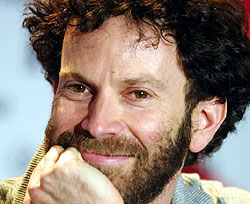 Correspondent: It’s safe to say that you are an idea man. So I must ask you: to what degree do you worry about an idea? Does your mind brim with more ideas — even correct ideas — than you can possibly use? Are you thinking of ideas right now? Is there a slight sense of panic with any idea? What is your idea of ideas?
Correspondent: It’s safe to say that you are an idea man. So I must ask you: to what degree do you worry about an idea? Does your mind brim with more ideas — even correct ideas — than you can possibly use? Are you thinking of ideas right now? Is there a slight sense of panic with any idea? What is your idea of ideas?
Kaufman: Well, this whole question is based on the premise that I am an idea man, which I’m not sure that I agree with.
Correspondent: Oh.
Kaufman: So I’m trying to break down what you asked me. And I don’t know. How am I an idea man? To turn this around. On you, Ed.
Correspondent: Well, I would argue that this film is laced with endless ideas meshing against each other.
Kaufman: Yes, it has a lot of ideas. But the ideas came over a two-year period, as I wrote the script. It’s not that I was furiously — like you or your girlfriend — furiously writing 700 pages in two days so that you could read it two days later. I mean, it’s slow. And sometimes it doesn’t happen at all for long periods of time.
Correspondent: So it’s the impression, I suppose, of being an idea man based on the final output here.
Kaufman: It’s not like it happens in real time. It’s not like there’s a two-hour movie and I wrote it in two hours.
Correspondent: Okay, well then let’s turn that…
Kaufman: I mean, I think you thought that before.
Correspondent: Oh certainly!
Kaufman: But it’s not true.
Correspondent: Let’s talk about it.
Kaufman: Let’s turn it around.
Correspondent: Okay. What is the actual ratio of you coming up with an idea? Is it one idea every 2.2 days? What’s the deal?
Kaufman: I would say that…(to himself) you figure two years….maybe it’s an idea a week.
Correspondent: And you have to determine whether…
Kaufman: And this is terribly disappointing for you.
Correspondent: Oh no! It’s actually quite interesting! I’m wondering. Do you have a certain….? Over the course of a week, do you determine whether that idea is correct in association with another idea? Is there kind of an idea peer review process that you run across in your mind? I mean, what’s the situation here?
Kaufman: There is no correct for ideas. Ideas are ideas. And if they’re interesting to me, they’re interesting to me. You know, I don’t know what an idea is actually. I think I think more in terms of emotions than ideas, although there are conceptual things that I utilize. Conceptual things that are devices or that are interesting to me. But the meat of the work for me is the emotional aspect of it. And I don’t know if you would consider those ideas or…
Correspondent: I think an emotional idea is nevertheless an idea.
Kaufman: Okay, then I…
Correspondent: You’re assuming that an idea is based entirely on cerebral terms. And I don’t think that’s necessarily the case.
Kaufman: Well, it may just be more the way that you’re presenting it. It feels….when you talk about ideas, and how many ideas you come up with, blah blah blah.
Correspondent: We’re presenting it in statistical data, yeah. (laughs)
Kaufman: It feels very cerebral.
Correspondent: Okay.
Kaufman: And scientific. And so yes, I have emotional ideas.
BSS #243: Charlie Kaufman (Download MP3)
Boris Kachka’s Original Notes for Article
After bribing a number of underpaid assistants with Duane Reade gift certificates (there was a stack here; don’t ask how we acquired it) and attempting to whisper sweet somethings into New York Magazine editorial interns who have been wrongly pegged as know-nothings, Reluctant Habits has obtained the early notes for Boris Kachka’s “Oh noes! The publishing industry is dead!” article. We don’t know what to make of Mr. Kachka referring to himself in the first person in these early notes, assuming the shaky provenance can be believed (and indeed we have grave doubts). But we presume that it’s the kind of casual hubris one employs when one is too embarrassed to refer to one’s self in the overused first person plural.
1. Okay, Boris, authenticity! Authenticity! Authenticity! Get the architectural details right! Employ modifiers like “drab” and “mysterious.” Use words like “demise” and “gallows.” Use Burton’s Anatomy of Melancholy for reference. We need the audience to cry uncontrollably. We need to create the impression that everyone who works in the publishing industry is crying uncontrollably. And, Boris, as you sit at the keyboard to write this, perhaps you will cry uncontrollably. Never let facts get in the way of the emotions!
2. You can never use enough exclamation points! Remember, we’re pulling back the curtain. The publishing industry is dead and has no hope! Watch the end of Planet of the Apes every 200 words to get the appropriate apocalyptic feel here. You publishing maniacs! You blew it up! Ah, damn you! God damn you all to hell!
3. Well, if Bob Miller is setting this thing up, then he IS the story! Never mind that the imprint is unproven. If you can’t point to specific examples with HarperStudio, then go with Jane Friedman! After all, she’s the one who greenlighted this, yes? Even if you can’t figure out the precise details of her sacking, suggest authority by providing details about her post-retirement party.
4. Insert random quotes every 500 words. The quotes don’t have to match up with the text that follows. But this should create an authentic enough feel.
5. Still struggling for title for piece. Watch Burt Reynolds movies.
6. Find a way to work in Lenin reference.
7. There’s an alternative here to the standard conglomerates take over everything angle, isn’t there? Surely, it can’t be that simple. Think, Boris, think! Uh, dot com days?
8. Dale Peck angle? We need someone making low six figures here. I mean, that’s the New York readership! Surely, nobody who pays less than $2,500 a month in rent reads this magazine. Demographic will sympathize!
9. Work in “long tail” reference. Shit on Chris Anderson if you can. Still vaguely fashionable, I think, to take a dump on Chris Anderson.
10. Suggest that Markus Dohle doesn’t know what he’s doing, but focus on appearance if you can’t locate the facts. Maybe describe Sonny Metha as “dapper.”
11. Constant comparisons to the old boozing days of publishing. Things used to be better. That never fails, eh?
12. Okay, we’ll never know what happened between Richard Ford and Fisketjon. But go for the gossip angle if necessary.
13. Get sources to say that nothing matters. Need at least three quotes. Preferably anonymous.
14. Wait, how else is the publishing industry dying? Causation does not imply correlation? Fuck that. BEA attendance was down! Work that in.
15. Work in Kindle.
16. Need list of “Books Gone Bust.” Shit, only four examples come to mind. Well, that’s enough, surely! Nobody’s going to pay attention to the titles that actually sell, are they? They’re going to believe our “publishing is dead” angle because I’m Boris Fucking Kachka!
17. When in doubt of your shaky knowledge about the publishing industry, Boris, have a good wank. Or three.

Subwaymarine

Ever wonder what happens to abandoned subway cars? Well, apparently, retired subway cars have proven to be quite helpful to the fish population just off coast of Delaware. Cars are dumped into the water, and the subway car’s roomy confines has resulted in fish taking to the cars like, well, water. (There have been other efforts to dump aircraft, automobiles, and other vehicles into the ocean to create these reefs. But the fish seem to like the subway cars the best.) Red Bird Reef, named after the famed Redbird cars being used for this experiment, has seen a 400-fold increase in marine food per square inch over the past seven years.
Red Bird Reef is not without controversy. The American Littoral Society has expressed concern that the small levels of asbestos within the glue used to affix floor panels and the like might prove damaging to the environment. And since there are only so many retired subway cars to go around, other states are trying to compete for the subway cars. (New York provides these subway cars for free.)
So is this a waste of manmade resources? A sullying of the environment? Or is it very possible that, given the declining fish populations in the Atlantic, it takes this extraordinary manmade reef to generate a sustainable fish population again?
Henry Miller on New York
(via The Publishing Spot)
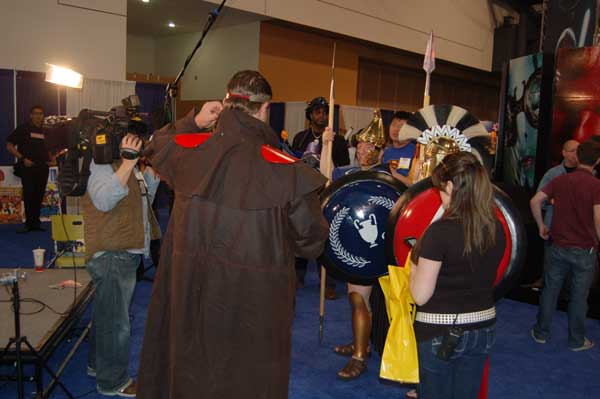
NYCC: An Impromptu Interview with Jeffrey Brown

On Friday afternoon, I began walking the floors of New York ComicCon, collecting strange snippets that will be glued together for a future installment of Segundo. I counted thirty-seven Jedi Knights (some of them portly, making me wonder why Jedi discipline doesn’t seem to involve physical fitness), two Stormtroopers (both in good shape), and two Princess Leias (both in remarkably gaunt shape and dressed to show this). If one must choose a side in the Star Wars/Star Trek dichotomy, I’m more of a Trek man myself, even though I recognize that the franchise is dead and hasn’t produced anything of quality since Deep Space Nine. Nevertheless, if costumes are anything to go by, there is a distinct sign that Trek is on the wane with the true believers.
I’m not quite sure what Roman centurions and Jedi knights have in common, aside from the fact Asimov’s Foundation series serves as the missing link between the two. But I must confess that, of all the costumes I espied, I was the most impressed with the Centurions (pictured above).
Speaking of Star Wars, I learned about the economics of lightsabers. A good lightsaber will cost you around $100. More if you want it customized. Joseph Semling, purchasing manager of Brian’s Toys, told me that he has anywhere from 20 to 100 lightsabers of any particular type in his warehouse. And if you’re wondering what a lightsaber dealer is likely to net, a lightsaber goes wholesale for about $75 and is then sold from anywhere from $25 to $50 more at retail. And if you’re wondering how Semling makes his money, he informed me that he raises the price of his lightsabers when the supply goes down. Like anything, the lightsaber is subject to a supply and demand curve. But even if the supply remains relatively stagnant, I suspect if Semling moved six lightsabers a day, discounting overhead, he could probably pay for his New York hotel room.
But the most intriguing conversation I had was with Jeffrey Brown, whose work I was apparently more interested in than I realized and whom I may have profoundly confused with my line of questioning. I’ll let the following partial transcript speak for itself. But Brown, I suspect, has more going on in his personal chronicles than most people realize. And I’m hoping that one day, I’ll be able to sit down with him and give him the full-length treatment he deserves.
Brown: I don’t really write about my personal sex anymore.
Correspondent: I know. But I’m saying that people are still interested in the past.
Brown: Yeah.
Correspondent: So this might be a conundrum. Many people are expecting more of that in the present and the future.
Brown: Well, um, I just keep dangling it in front of them. Well, that sounds bad.
Correspondent: (laughs)
Brown: What I mean to say is that maybe I can just make it seem like I might write more. But I’ll really just write whatever I want.
Correspondent: Okay, I propose something for you. What if you were to fictionalize the personal and therefore it’s not personal sex. But it’s fictional sex. I mean, you did that with the robots. But to have a story that doesn’t involve you as the chief protagonist.
Brown: I have lots of ideas and I’ve got a couple more autobiographical things that I want to cover. Including writing about religion. Growing up with my dad being a minister. And I want to write a book about pregnancy. And the book I’m working on right now is about becoming a cartoonist. And then once those are out of the way, I have some ideas about fiction-like stories that I want to get into. Although the first one, at least, there’s no sex. Well, there could be. I don’t know. I haven’t written it yet.
Correspondent: Well, it’s not all sex. I’m just trying to point out the first-person vs. third person vs. fictive vs. real and all that.
Brown: Well, if you don’t know me, I guess it’s all fiction writing.
Correspondent: I don’t actually. I don’t know you.
Brown: Well, you kinda do.
Correspondent: Well, not entirely. Because this is entirely true. That’s the question.
Brown: But to people listening to this, they don’t know.
Correspondent: Well, now they know. Now that we’re talking about it. We’re clarifying.
Brown: But to them. To them, this could be fiction.
Correspondent: Oh, you may not even be Jeffrey Brown.
Brown: That’s true.
Correspondent: Okay, so let’s talk about this reality vs. what you put in your books.
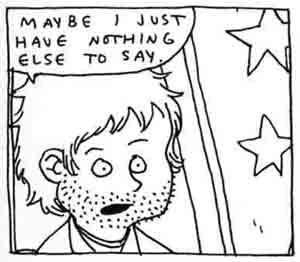 Brown: Well, it’s something. And I haven’t entirely figured out why. I mean, there’s something about when you know it’s true. There’s something about that honesty, that authenticity, that kind of heightens the impact of things sometimes. Which is why I’ve avoided doing more fictionalized autobiography. And sometimes I’ve thought about moving in that direction. And then it just doesn’t feel right for what I’ve done so far. But on the other hand, books — like some of the Bighead stuff — there are some very personal autobiographical elements sort of in there. So in a way, I kinda do it occasionally. In various half-assed ways.
Brown: Well, it’s something. And I haven’t entirely figured out why. I mean, there’s something about when you know it’s true. There’s something about that honesty, that authenticity, that kind of heightens the impact of things sometimes. Which is why I’ve avoided doing more fictionalized autobiography. And sometimes I’ve thought about moving in that direction. And then it just doesn’t feel right for what I’ve done so far. But on the other hand, books — like some of the Bighead stuff — there are some very personal autobiographical elements sort of in there. So in a way, I kinda do it occasionally. In various half-assed ways.
Correspondent: I’m wondering what boundaries you’re placing on yourself as you’re getting older. As you have a family. And all that.
Brown: I definitely. Well, not writing about personal sex anymore. There’s boundaries there that I’m much more aware of. You can see that in the new book, Little Things, where everything’s approached from a slightly different direction. Where I’m much more careful about what I’m revealing and how I’m revealing it.
Correspondent: But this issue of authenticity that you were talking about earlier, I mean, this causes a bit of a problem if you have boundaries like this.
Brown: Unless you just ignore it. Fuck it. I’m going to do — oh wait, can I say that?
Correspondent: No, you can say whatever you want.
Brown: This is going on the Internet? Oh, Internet. Then I just leave those questions up to people analyzing the work. Then I just ignore the problems.
Correspondent: Now wait a sec. Wait a sec. That was a very great way of evading the question.
Brown: I know. I tried earlier.
Correspondent: Yeah, I know. Well, I’m going to have to put it — just try to get an answer on this notion of how you retain truth despite having these boundaries.
Brown: (laughs) I mean, certainly there’s a theory that some people have. That fictionalizing — that by lying, you can get at a more real truth. So in that sense, whatever boundaries I have, I’m walking some sort of line between those boundaries forcing me to reveal some kind of more pure truth in that sense. But then we can go into how reliable is my memory. I think people who know me would generally say that I’m pretty honest. But it’s also possible that it could all be a big act. And I’m a really good actor. Totally. But —
Correspondent: The issue I have is here you are putting some kind of identity. It doesn’t really matter how true it is.
Brown: Right.
Correspondent: Nevertheless, it is true in some sense. And then there are these boundaries on top of that. So as a result, you’re painting yourself into these interesting limitations. Possibly to be more creative.
Brown: And I think the other thing to is that I tend to think of all the autobiographical works as a bigger picture when you put them together. So one book, for example, might have a lot of boundaries in some way that limit what you’re seeing from that book. It’s a very limited view of me as a person or as a character. Or however you want to put it. But when you read the other books, they all kind of inform each other. And so it’s like a tapestry of information that combines. It’s almost like it gets around those boundaries. Maybe.
Correspondent: Well, I also ask this because, in Little Things, you’re very clear about when things happen in that. You actually date the stories. If I’m thinking of the right collection. This happened during this particular time. I drew this during this particular time. And so as a result, it seems to me that there is an effort on your part to be truthful here.
Brown: No, I was just ripping off John Porcellino with that. No, I actually was ripping off John Porcellino. Well, I do that. And if you look in Unlikely, where there’s the drawings from photographs. Or AEIOU, where there’s the receipt from the dinner. And that stuff’s kind of just an additional way of telling people that, despite those boundaries, I’m trying to be as honest as possible and as forthright. Obviously, there’s probably some weird subconscious thing going on. There’s things that I’m not saying. Or things that I’m in denial about maybe. But what I’m trying to do is be honest.
[UPDATE: Our NYCC podcast, featuring this interview and others, including chats with Kyle Baker and Scott McCloud, should go up soon. But alas, I’m now on deadline. But I’m hoping to get the podcast up once I beat these deadlines.]
NYPL: Nicholson Baker & Simon Winchester
On Thursday night, a crowd congregated into a subterranean hall of the New York Public Library to listen to Simon Winchester interview Nicholson Baker. Mr. Baker wore a green vest and a low-key suit. Mr. Winchester was dressed in a gaudy blue pinstriped suit and a yellow shirt, with a dark red handkerchief drifting out of his outer pocket like a haphazard eleventh-hour accessory.
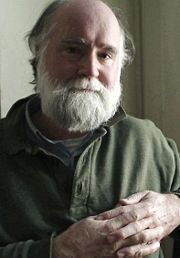 Baker was soft-spoken, effusive with his hands, and sometimes quietly gushed, particularly when talking about the “lush, colorful” nature of the New York World, one of the early 20th century newspapers that had been in his prodigious collection. Winchester was often sharp and crisp with his questioning, exuding the aura of a fussy countertenor waiting for a cadre choristers to marvel upon his ostensible magnificence, but he was good enough to point out that it was “Nick’s night.” At one point, Winchester poured water only into his glass. Baker, by contrast, filled both his own glass and Winchester’s. Winchester kept his gaze upon Baker throughout the conversation, rarely glancing to the audience. Baker, by contrast, regularly opened himself to the audience when expressing himself.
Baker was soft-spoken, effusive with his hands, and sometimes quietly gushed, particularly when talking about the “lush, colorful” nature of the New York World, one of the early 20th century newspapers that had been in his prodigious collection. Winchester was often sharp and crisp with his questioning, exuding the aura of a fussy countertenor waiting for a cadre choristers to marvel upon his ostensible magnificence, but he was good enough to point out that it was “Nick’s night.” At one point, Winchester poured water only into his glass. Baker, by contrast, filled both his own glass and Winchester’s. Winchester kept his gaze upon Baker throughout the conversation, rarely glancing to the audience. Baker, by contrast, regularly opened himself to the audience when expressing himself.
Shortly after sitting in his seat, Winchester announced to the crowd, “This is not going to be a lovefest.” But despite this pledge of pugilism, Winchester played it relatively safe. He had snide comments pertaining to Adam Kirsch’s review. Contra Kirsch, he pointed out that “stupid, but scary” seemed an appropriate line to discuss war.
Alluding to Checkpoint, Baker observed that his purpose in writing that novel was to ask a simple question: “If you think that your single action can solve the problem, is there a way that someone can talk you out of the problem?” But Baker pointed to Emily Dickinson’s maxim about telling all the truth but telling it slant. Fiction could only go so far. And thus, Human Smoke emerged from these meditations.
Baker pointed out that for every book he has written, he would generally get one third of the way into it before “something goes wrong.” Then, he sets it aside. But he had been working on a book-length history of the Library of Congress, dwelling in particular upon Archibald MacLeish, who was the Librarian of Congress in 1939. MacLeish would go onto become a key propaganda figure during the war. And thus Baker found himself immersed in “an interpretive problem.” He had to understand World War II. So he put aside this project and Human Smoke began to take shape.
In discussing the difference between his fiction and nonfiction, Baker noted, “Fear plays a large part in all this. You want to avoid exposing himself.” It was with this attitude that he tackled the more elaborate project of Human Smoke, of which he pointed out that he couldn’t do justice to the full experience of the war.
Winchester asked Baker about whether it was reasonable to rely almost exclusively on newspapers — the so-called first draft of history — for his book at the expense of historians who came later. Baker pointed out that the reporter who wrote about a major event he experienced “had the balance of things in his mind that brings you to the moment.” He cited the exploding soup cans during the bombing of Coventry — a detail that seemed particularly apposite to his framing of history. He pointed out that newspapers would reprint the entire text of a radio speech and noted that, within the letters to the editor section, one could find a great array of voices.
In dwelling upon Human Smoke‘s cast of characters, Baker expressed great curiosity about Herbert Hoover and pointed out that Victor Klemperer was “an interesting man, a sad man.” But he pointed out that just because he put a quote into the book, this did not mean that he necessarily believed in it. Of Gandhi, he observed, “Sometimes there’s a coldness that’s very disturbing.”
Baker appeared deeply troubled by World War II priorities. He said, “It was easier to fight a war against Germans than it was to allow Jewish refugees.” But he pointed out that he was not qualified. On the question of whether America knew about the Pearl Harbor invasion in advance, Baker opted to “defer to the experts.” Later in the evening, Baker said, “Who were the people who came out of the war with greatness and nobility? The Jews.” And there was an uncomfortable silence from the audience, who began to grow a bit restless.
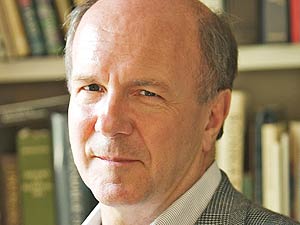 When I interviewed Mr. Winchester in late 2006, he insisted to me that he was a historian, not a journalist, and expressed umbrage at my notion that he was “covering” the 1906 earthquake, pointing out that historians look back on events with “perspective.” This perspective, however, was not particularly evident last night.
When I interviewed Mr. Winchester in late 2006, he insisted to me that he was a historian, not a journalist, and expressed umbrage at my notion that he was “covering” the 1906 earthquake, pointing out that historians look back on events with “perspective.” This perspective, however, was not particularly evident last night.
Four of his questions pilfered very specific points that were presented during the Human Smoke roundtable discussion — all, of course, without reference. Not only did Winchester read aloud the exact same section from Checkpoint that was referenced on these pages, but he also brought up Jeanette Rankin, the controversy involving the Treaty of Versailles (raised by Colleen Mondor), and the efforts by Cardinal Clemens von Galen to suspend the T-4 program. I wondered if Winchester had spent that afternoon Googling to prepare for a book that had slipped his mind since he blurbed it many months ago.
There was a telling indicator of this propensity during the post-discussion Q&A. Asked about Human Smoke, Mr. Winchester pointed out that he had problems with Baker’s book, but that he would defend his right to write it. The delightful and quick-thinking Paul Holdengräber pointed out that Winchester’s line had originated from Voltaire.
Despite these quibbles, I actually liked Winchester. He was dry and mostly unsmiling, save through a few belabored grimaces that seemed more directed at the CSPAN cameras dutifully videotaping this conversation for Book TV than the audience who had shelled out $15 a head to see this. But he was quite entertaining as a Jeremy Paxman-style interviewer. At one point, he asked Baker point blank about the apparently unquestionable natural impulses that cause people and creatures to kill, citing a gorilla video that had been emailed to him, and some incident involving chickens on his cozy farm in Connecticut as evidence of these apparent impulses. He even managed to find a way to name drop Tom Brokaw — “who is a friend and who I like.” Winchester was an enjoyable blowhard, more Phineas Barnum than Phineas Finn. And juxtaposing his blustery presence with the more empathic Baker worked quite well.
Despite revealing himself later to be a dedicated Malthusian (and this charge seemed more a piece of contrarian theater than bona-fide ideology), Mr. Winchester partially acquitted himself when he bailed Baker out as he was responding to a question from the audience about whether America should now begin negotiating with Islamic fundamentalists. As Baker fumbled for an answer, Winchester quickly pointed out that the Northern Ireland crisis was resolved by talking the issue out through back doors.
As the crowd dissembled, Winchester ran up and down the signing line, balancing books like a juggler signed on for a circus at the last minute. I kept wondering whether he was carrying out some intriguing one-man dramatization of a Tom and Jerry cartoon, but this was not the case. He asked a few folks in the queue if anyone else wanted him to sign his book so that he could go home.
Baker appeared a bit worn out by all the publicity he’s been doing for Human Smoke. But despite his energies waning near the end, he maintained a great humility and offered some lively remarks for a book that is likely to keep fanning the flames of controversy for quite some time.
Night at the Boxcar

This was roughly the view you received if you had the privilege of attending the Boxcar Lounge on Wednesday night. The venue was indeed shaped like a boxcar and it was SRO for those souls, like Levi and me, who had arrived from McNally Robinson. (Of that counterprogramming, while John Freeman made a valiant attempt to ask questions of Lee Siegel that would cause him to think instead of fulminate more on his puerile anti-Internet views, the two of us left after twenty minutes. Siegel, as a speaker, has the voice of a semi-squeaky plush toy that still has a bit of air left, but hasn’t yet figured out that the tots have moved on to newer baubles. I had seen this kind of arrogant and opinionated blather before when the speaker had referred to itself as Andrew Keen. So there was no need to subject myself to it again. To offer a small sample: According to Siegel, the Internet is apparently composed of 80% porn. And while it’s absolutely diabolical for people to leave anonymous and hateful comments (as they did for Siegel’s posts at the New Republic), apparently it’s perfectly peachy keen for Siegel to impersonate “sprezzatura” because there is nothing forbidding such a cheap impersonation under journalistic rules. Never mind that Siegel’s shenanigans were hardly transparent and had to be ferreted out by top brass at the New Republic. I took notes, but I felt like I was transcribing a kindergarter’s efforts to discuss Kant’s Critique of Pure Reason based on a one-sentence summary. As such, my notes are not worth reproducing or summarizing.)
You couldn’t get a seat at the Boxcar Lounge. Unless you were one of the smart ones, like Maud and her friend, who arrived early to get a seat. There were many bloggers in the crowd, including Jason, Levi, Marydell, Lauren, and Sarah. It was also a pleasure to talk with Michael Orbach, Jami Attenberg, and a number of other people who I will no doubt remember after I hit the “Publish” button. I’m sorry.

Besides, who needed Siegel when there was another installment of Jami Attenberg’s Class of 2008 Reading Series going down? This one featured Michael Dahlie reading from A Gentleman’s Guide to Graceful Living, Lynn Lurie reading from Corner of the Dead, and (pictured above) Ceridwen Dovey reading from Blood Kin. Dovey was one of the evening’s standouts. Her reading was quietly intense and suitably genteel, and I am now most curious about her novel.

And then there was Mr. Sarvas himself, who read from a chapter of his forthcoming novel, Harry, Revised: the infamous incident in the bookstore. The chapter contains a disparaging reference to David Foster Wallace and I felt compelled to cry out a “Yea!” in DFW’s defense. Mark likewise felt compelled to point to me during this moment.
Is Harry, Revised any good? I was a bit hesitant to approach it, as my candor compels me to tell even my closest friends when their work is not up to snuff. But I have read the whole of Harry, Revised and I can recommend it. Mark has ventured down a somewhat unexpected path here, unafraid to have his protagonist enter into uncomfortable territory. The book’s style displays Mark’s clear love for Fitzgerald and there is something of a French farcical feel that permits material that should not work to be executed with a crazed grace.
I am sorry to report, however, that there remains one passage that will almost certainly be nominated for The Bad Sex Award. But you’ll have to wait for a forthcoming installment of The Bat Segundo Show to find out precisely what it is.
Forgotten Statue, Forgotten Spirit
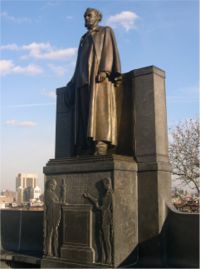 Like many statues nestled along the rectangular trestles of Manhattan’s parks, Karl Bitter’s bronze depiction of Carl Schurz — situated at the corner of Morningside Drive and 116th Street — is regularly overlooked by many New Yorkers. They walk their dogs. They chat on their cell phones. They rush to important appointments or set out to beat a jogging record. But they rarely stop to observe this rather tall and intriguing figure who remains memorialized.
Like many statues nestled along the rectangular trestles of Manhattan’s parks, Karl Bitter’s bronze depiction of Carl Schurz — situated at the corner of Morningside Drive and 116th Street — is regularly overlooked by many New Yorkers. They walk their dogs. They chat on their cell phones. They rush to important appointments or set out to beat a jogging record. But they rarely stop to observe this rather tall and intriguing figure who remains memorialized.
That’s saying something, considering that Schurz is quite vertical in design (he stands nine feet tall), his left foot juts a mite forward, and his portly girth, disguised by a thick and definitive bronze coat and cape, demands attention. To look over the promontory where Schurz is propped, you must walk up three stone steps to get an unoccluded view. But no matter what building your eyes settle upon, Schurz will remain in dogged peripheral vision. Maybe pedestrians are vexed by Schurz’s hatless and Germanic form — for what it’s worth, he does politely hold his hat in his right hand — invading Harlem’s horizontal vista, which, like every Manhattan neighborhood, is now undergoing terminal gentrification. Perhaps to live in New York, the New Yorker cannot look upon the past, but must continue contending with the swift-paced momentum of the present. And if that means accepting glass monstrosities in lieu of charming brick buildings without remonstrance, so be it. But this willful acceptance also extends to figures like Schurz, who reminds us that there was indeed a New York before the present one.
The Schurz statue is unsullied by the verdigris now eating away at another of Bitter’s sculptures — that of Franz Sigel residing on West 106th Street and Riverside, currently earmarked for renovation. Schurz and Sigel both have parks named after them. (Karl Bitter, alas, does not. New York reserves its laurels for its heros, not the artists who render the legacy.)
We know that Schurz was a military man, a political reformer, and a journalist. He spent the majority of his life outside of New York, served as Secretary of the Interior for President Rutherford Hayes, moving to the city in 1881, ostensibly to retire. But a man of his insurmountable energies could not settle down. He had twenty-five years left in his life to make a name. And he did. Starting with his immediate rise to editor-in-chief of the New York Evening Post in 1883 and followed by becoming one of the Mugwumps supporting Grover Cleveland the following year. He spoke out against Tammany Hall, drawing enthusiasm for his remarks even as a fife and drum corps passed by.
The first fact that, in our efforts for good government, stares us in the face is the existence of an organization — Tammany Hall — whose very purpose it is to give the city the worst government it dares, to the end of making money out of it. And this organization has been for years, and is now, in full possession of the municipal power.
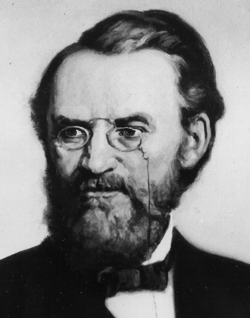 Schurz spoke these words as two friends of his were the top mayoral candidates. He would not let friendships get in the way of principle. Likewise, he did not think much of William Jennings Bryan and also campaigned against him.
Schurz spoke these words as two friends of his were the top mayoral candidates. He would not let friendships get in the way of principle. Likewise, he did not think much of William Jennings Bryan and also campaigned against him.
As the New York City Department of Parks & Recreation is proud to announce, he was an adopted New Yorker and was often unpredictable with his political choices. Schurz was gleefully antagonistic, and on September 22, 1900, he resigned his Presidencies of the National Civil Service Reform League and the Civil Service Reform Association of New York, observing, “I frankly confess that on account of my position of antagonism to other policies of the Administration, the performance of my part of that duty is especially unwelcome to me.” But he could not quite give this ghost up and was elected the following year as President of the Civil Service Reform Association.
When Schurz was buried in Sleepy Hollow in May 1906, he had an audience both rich and poor. Andrew Carnegie and Joseph H. Choate stood beneath one umbrella. The Times described Schurz as “a publicist and patriot.” The funeral was attended only by relatives and close friends, but policemen had to stop many who hoped to get a view of Schurz’s coffin. It was Choate who ensured that the statue now standing in Morningside Park was completed.
Schurz had a reformist ebullience scarcely seen in the present political age. We now seem to settle for charisma and monoglot messages about hope. Those who do stand out are censored or declared too lunatic for the political arena. This stands in sharp contrast to the words Choate unfurled during the statue’s unveiling, “As a leader he did what is so seldom seen and yet so necessary in the upholding of the best in public life. He put expediency above personal and party advantage. He never allowed party to lead him in the wrong direction, and for years he stood alone, an independent figure in party and public life.”
At the pedestal before Schurz’s form are the words: CARL SCHURZ Defender of Liberty and Friend of Human Right.
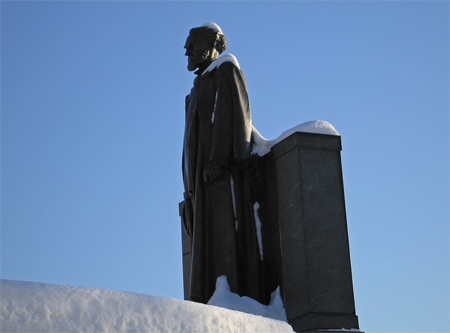
Today, who knows Schurz’s name outside of hard-core history buffs, fans of The Who, and curiosity seekers? Not long ago, when I visited Schurz’s statue, I observed a broken bottle of Gilbey’s upon the faded ornamental brick. The bottle had apparently been thrown at Schurz, and the glass shards glistened more resolutely than the brick. While the bottle, in all likelihood, had been hurled by a cavalier youth, I couldn’t help but contemplate whether there was a rejection of Schurz’s spirit in the air. History was apparently the work of others. But it seemed to me that it was the other way around.